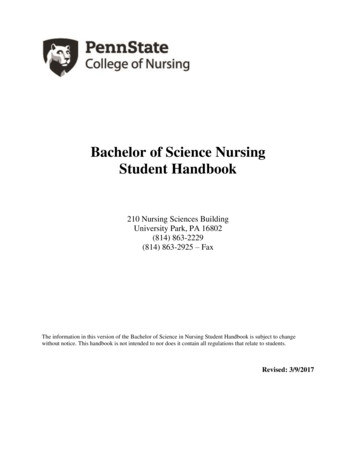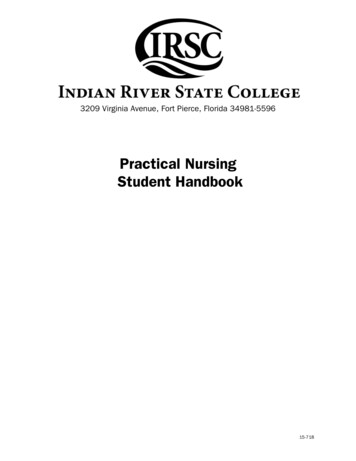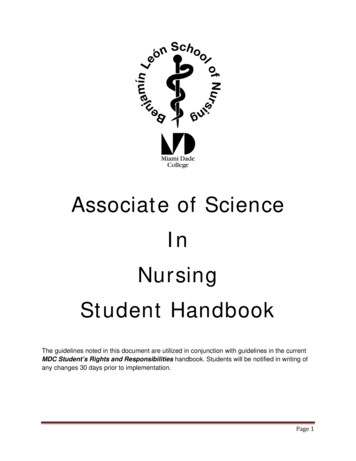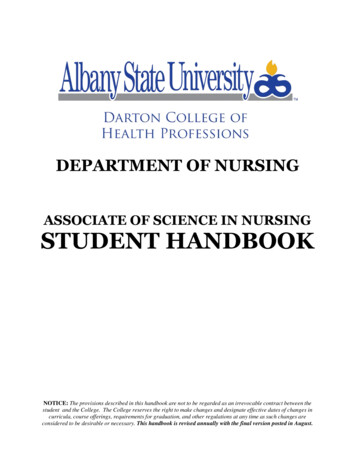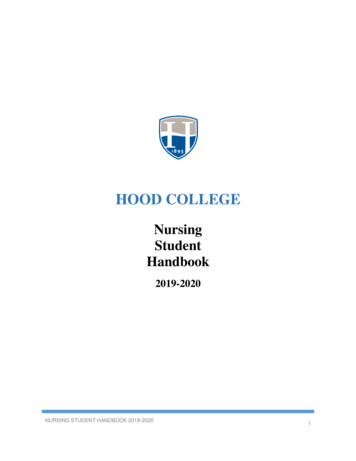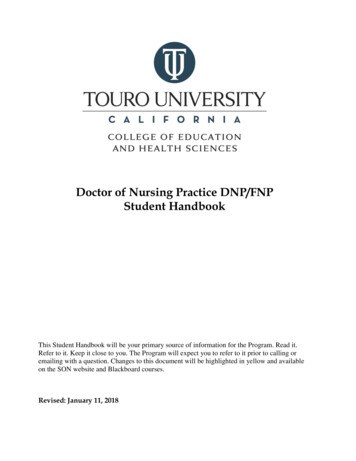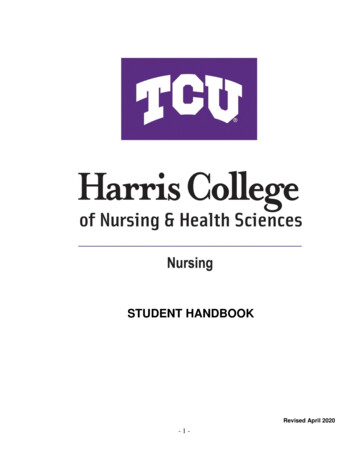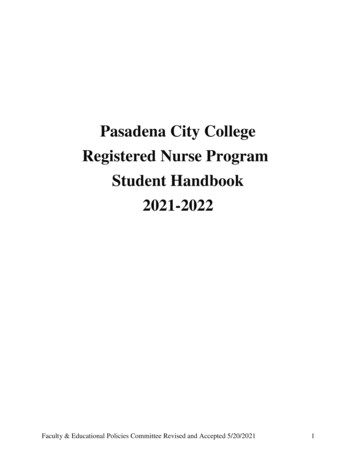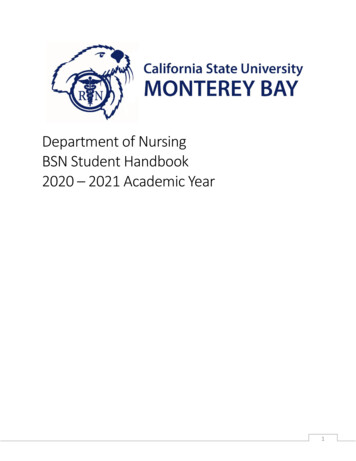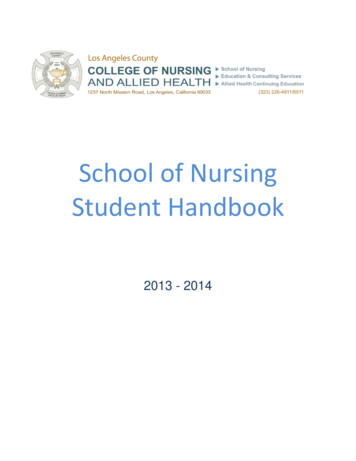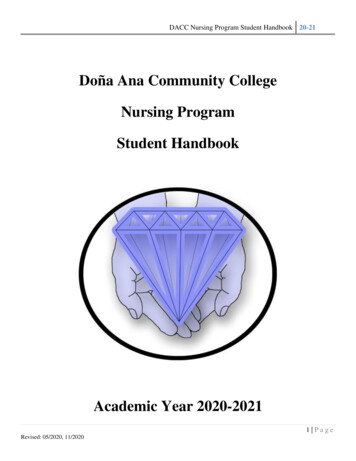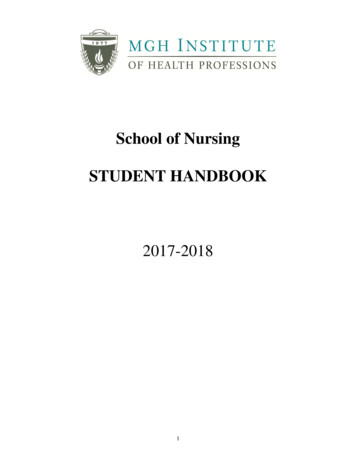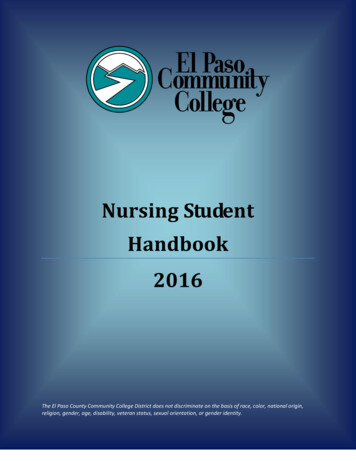
Transcription
Nursing StudentHandbook2016The El Paso County Community College District does not discriminate on the basis of race, color, national origin,religion, gender, age, disability, veteran status, sexual orientation, or gender identity.UZ2/Zip 4/Nursing Student Handbooki
TABLE OF CONTENTSPageNURSING PROGRAM INFORMATION .1This section focuses on the frame work of the program and the basic elements thathelp develop the curriculumIntroduction .2Philosophy.3Organizing Framework .7Operational Definitions .8Associate Degree Nurse Program Outcomes .13Vocational Nurse Program Outcomes .14Student Learning Outcomes: Associate Degree Nursing.15Student Learning Outcomes: Vocational Nursing .16STUDENT PARTICIPATIONThis section focuses on student participation and concerns17Nursing Program Committees.18Resources Committee .18Student Committee.18Pinning Committee .18Student Nurse Association .19Student Concern Form .20DRUG DOSAGE PROCEDURESThis section focuses on all medication and drug dosage proceduresIncluding safety21Procedure Pre-Clinical Drug Calculation Assessment .22Policy for Drug Dosage Calculations .23Procedures for Testing Drug Dosage Calculations .24Procedure on Medication Administration .25Instruction Sheet for All Drug Calculation Exams .28Definitions for IV and IV Push Medications .32Medication Error Guidelines.33GENERAL NURSING PROCEDURES34This section focuses on progress in the program, course and program standardized testing,including other procedures of interestProgression in the Nursing Program .35Procedures for Written Examinations Quizzes and Clinical.36Procedure on Rounding of Grades .38UZ2/Zip 4/Nursing Student Handbooki
EPCC Nursing Student Handbook 2016PageProcedure on Standardized Testing .39Total Testing Program - Associate Degree .41Total Testing Program - Vocational Nursing.42Student Counseling/Contracts .43Physical and Technical Standards for Students in HealthOccupations Programs 7.02.01.14 (EPCC Policy) .44Student Declaration Physical/Technical Competencies for Health OccupationsPrograms .48Guidelines for Students with Disabilities .51Student Reentry into the Nursing Program 7.02.01.26 (EPCC Policy .53LABORATORY SAFETY GUIDELINESThis section focuses on Laboratory Safety60Nursing Laboratory Guidelines .61Laboratory Safety Guidelines .62Needle, Blood and Body Substance Precautions .64Computer Use Policy .66Responsible Computing at EPCC .67NURSING PROCEDURES FOR CLASS AND CLINICALThis section focuses in class, clinical, and post admission information69Clinical Assignment .70Clinical Rotations.72Transportation .72Military .72Student Nurse Supply Kits .72ATI Standardized Testing .72Community-Wide Orientation .73Affiliate Computer Orientations .73Affiliate Computer Codes .73HIPAA Confidentiality .73Immunization Requirements Including Cpr And First Aid .74Criminal Background Check.76Expenses .79Nursing Skills Lab Dress Code .80Clinical Affiliate uniform Code .80Nursing Skills Lab Dress Code .81Accessories for Lab and Clinical .82Charting/Documentation (including Admission Nursing Assessment .86UZ2/Zip 4/Nursing Student Handbookii
EPCC Nursing Student Handbook 2016PageETHICSThis section focuses on ethics and student conduct88Ethics . 89National Council of State Boards of Nursing – NCBN .90Student Bill of Rights and Responsibilities . 91Code of Academic and Clinical Conduct . 93Code of Professional Conduct . 95Honesty Policy – Testing . 96Scholastic Dishonesty . 97Procedure on Scholastic Dishonesty . 98Student Absenteeism and Clinical Theory and Laboratory Grades .100Criteria for Unsafe Clinical Practice .104Physical Jeopardy .106Emotional Jeopardy .109Background Checks for Licensing .110Convictions-Declaratory Orders .111Rule §213.30 Declaratory Order of Eligibility for Licensure .114Petition for Declaratory Order .117Definitions .119Rule §213.28 Licensure of Persons with Criminal Offenses .122Rule §213.29 Criteria and Procedure Regarding Intemperate Use and Lack of Fitnessin Eligibility and Disciplinary Matters .128Rule §213.27 Good Professional Character .132Rule §217.11 Standards of Nursing Practice .134Rule §217.12 Unprofessional Conduct .137BOARD OF NURSING EXAMINER (BON) INFORMATIONThis section focuses on licensure and practice140Rule §217.2 Licensure by Examination .141Rule §217.3 Temporary Authorization to Practice .143Rule §217.5 Temporary License and Endorsement .145MISCELLANEOUS INFORMATION147Student Employment or Volunteer Work .148UZ2/Zip 4/Nursing Student Handbookiii
EPCC Nursing Student Handbook 2016PageSTUDENT FORMS150Student AcknowledgmentPolicy for Social Media and NetworkingPatient ConfidentialityHealth Occupations Division--Release of Information151152153154UZ2/Zip 4/Nursing Student Handbookiv
NURSING PROGRAM INFORMATIONUZ2/Zip 4/Nursing Student Handbook1
EPCC Nursing Student Handbook 2016INTRODUCTIONThe Nursing Division of El Paso Community College includes two nursing programs, which aredesigned to meet the personnel needs of this community. With your entry into your NursingProgram, you have become an integral member of the HEALTH CARE TEAM. An importantportion of your educational program is the clinical experience you will receive in the communityas a part of your program. These clinical experiences require special preparation and practiceson behalf of the College, the Nursing Programs, and the students.This handbook contains only the specific procedures which relate to the Nursing Programs anddoes not take the place of the information concerning college procedures and regulations whichyou will find in the College Catalog, the El Paso Community College Student Handbook, theCollege website, or your individual course requirements.NOTE:At the Student-Faculty meeting you will sign pages that are kept on file eachsemester. These pages include the following:ConfidentialityRelease of InformationPolicy for Social Media and NetworkingWe hope that the Nursing Student Handbook will be a useful guide as you prepare for yournursing career as a student in a nursing program.Vision StatementThe El Paso Community Nursing Program shall be the progressive leader in high-quality,innovative nursing education opportunities in response to the health care needs of a multiculturalborder community.Mission StatementThe mission of the nursing discipline is to improve health care by providing qualified nurses whoare prepared to work in a culturally diverse border community.2
EPCC Nursing Student Handbook 2016EL PASO COMMUNITY COLLEGENURSING PROGRAM PHILOSOPHYThe nursing faculty of the Career Ladder Nursing Program agrees with the mission, vision andthe core values of a learning college ascribed by the El Paso County Community CollegeDistrict. We must provide an opportunity and support services that prepare individuals toimprove their personal quality of life and to contribute to their economically and culturallydiverse community.The nursing faculty believes that nursing education can be improved through the implementationof a Career Ladder concept which allows individuals to progress in the educational system byproviding multiple educational pathways leading to an entry-level license to practice as avocational or associate degree nurse. Inherent in our philosophy are our beliefs about theindividual, nursing, health, the environment, teaching, learning, nursing education, the roles ofthe associate degree nurse, and the roles of the vocational nurse within the scope of nursingpractice.IndividualEvery individual is unique, of infinite value, and worthy of respect. Each individual is aculturally diverse composite of inter-related biological, psychological, sociological, cultural andcommunicating needs that influences the individual’s perception of their health. The individualis autonomous and has the right to make decisions about his/her own health care. The individualand family are the recipients of nursing care that focuses on meeting their needs.NursingNursing is a humanistic and a professional health care discipline founded on knowledge from thesciences, humanities and human experience. It is a scholarly profession that utilizes theoriesfrom nursing and other disciplines. Nursing employs integrity, accountability, clinical judgmentand caring behaviors to guide its practice for health promotion and disease prevention, healthmaintenance and health restoration. Nursing advocates for the individual and family throughoutthe life span and in the final stages of life. Through the use of the nursing process, criticalthinking and therapeutic interventions which are supported by current evidence-based research,the nurse is able to provide, holistic nursing care for the patient and family across the life span.The nurse must have the ability to utilize a variety of current technologies and nursinginformatics to provide safe and effective patient-centered care in a variety of health settings.HealthHealth is a dynamic state that is influenced by each individual’s inherited characteristics and lifeexperiences. It is an individual’s perception of the satisfaction with their own state of wellbeing. It may or may not be related to the presence or absence of disease, but rather the patient’sperception. Humans perceive themselves as healthy or ill as a consequence of the relationshipbetween themselves and their environments. At any given time a person’s health status is seenas being at a point on a continuum that extends from wellness to the cessation of life.3
EPCC Nursing Student Handbook 2016EnvironmentEnvironment is the domain in which individual and family exist. The interaction between theenvironment and people affects health, well-being, growth and development and the degree towhich individual needs are met throughout the life cycle. The reciprocal relationship betweenthe person and environment is influenced by both internal and external factors. Internal factorsinclude the biological, psychological and spiritual attributes of the person. External factors arecomprised of physical, chemical, sociocultural, economic, political, legal, and ethical elements.TeachingTeaching is a process, aimed at facilitating the achievement of learning. It is an intentionalinteraction between the teacher and the learner, requiring a focus on mutual goals. It involveslogical, strategic, and instructional activities to facilitate changes in interest, motivation,perception, insights, and behavior in the learner. Teaching should include a variety ofinstructional methods to meet individual student learning needs. It is most effective whenoutcomes are stated in measurable behavioral terms, so that the student knows how learning is tobe evaluated. The teaching process and the learning process cannot be separated.Teaching is also a dynamic process which is used by nurses to assist in the education of patients,families and significant others. The nurse is expected to assess the learning needs and todevelop, implement, evaluate, and modify teaching plans designed to expand the knowledge baseand skills of the patient.LearningLearning is an active, internal, and continuing process by which an individual acquires newknowledge through the integration and evaluation of concepts and skills. It is enhanced when thelearner assumes responsibility for learning. It is further enhanced by direct application, readinessto learn, relevance to the learner, reinforcement of desired behaviors, use of all the senses, andthe learner’s prior life and work experience. Learning progresses from simple to complex, fromgeneral to specific, and from concrete to abstract.Nursing EducationThe faculty believes that education is based on humanistic approaches that foster critical thinkingand promote awareness of social and cultural diversity among individuals. The faculty cares foreach student as a unique individual with special talents, abilities, needs and goals. Culturaldiversity, varying life experiences, and changing socioeconomic factors affect each studentdifferently. To this end, faculty endeavor to provide an environment that assists students torealize their full potential. The acquisition of professional knowledge, communication skills,clinical competence, and clinical judgment occur through active involvement of the student inthe teaching and learning process. Students assume primary responsibility for learning, whilefaculty provides educational opportunities for knowledge acquisition and professional roledevelopment. The faculty mentors, facilitates, motivates, guides, and directs the learningexperience. Synergistic exchange between student and mentor encourages a learningenvironment that embraces excellence. Faculty believes that technology and nursing informaticsis imperative in academic teaching and professional/vocational practice.4
EPCC Nursing Student Handbook 2016Education is seen as a continuous, life-long process through which individuals expand learning,enhance practice ability, or qualify for employment positions. The graduates of both theVocational Nursing Program and the Associate Degree Nursing Program are prepared to functionwithin the roles of the nu
UZ2/Zip 4/Nursing Student Handbook i Nursing Student Handbook 2016 The El Paso County Community College District does not discriminate on the basis of race, color, national origin, religion, gender, age, disability
